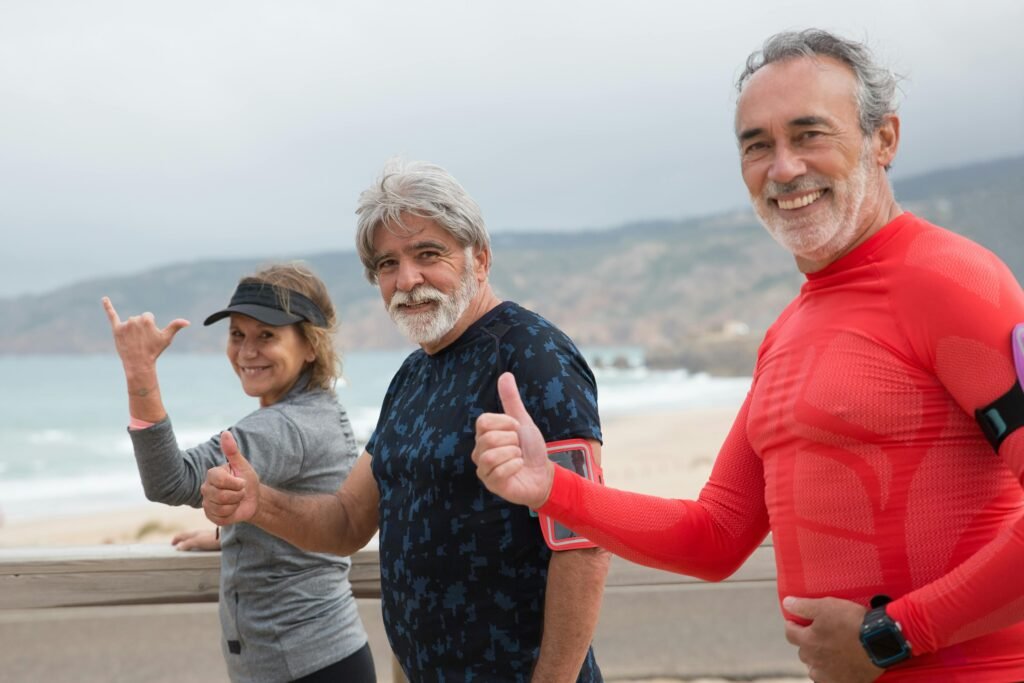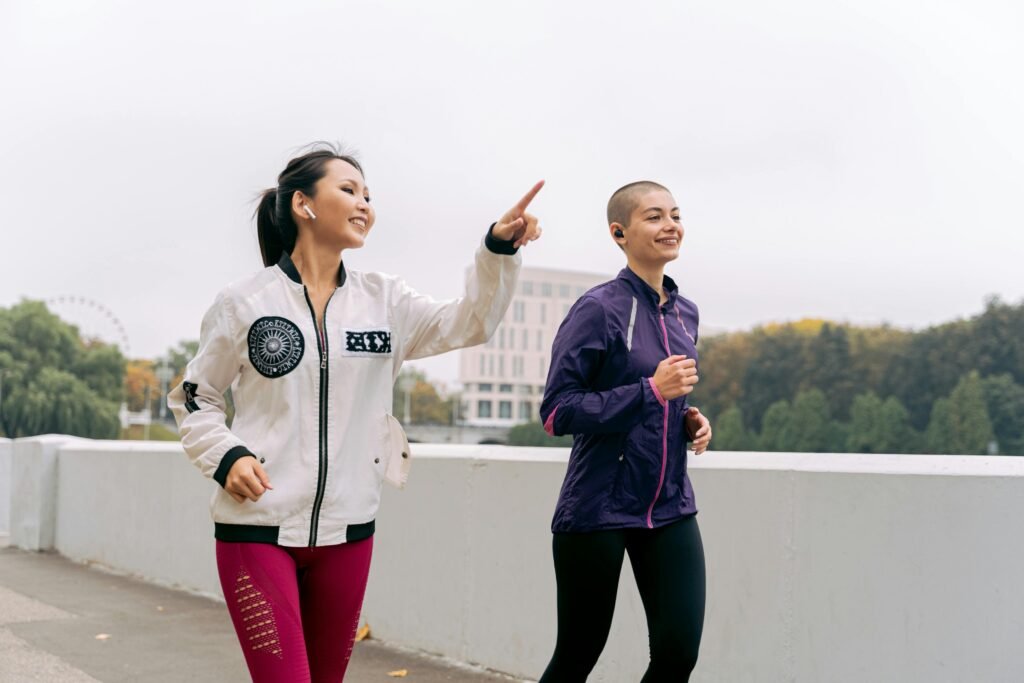Tips to Stay Active and Healthy as You Age

Staying active and healthy as you age unlocks a world of benefits that can transform your daily life. Exercise Programs for Older Adults: offer a fantastic way to strengthen muscles, improve joint health, and enhance balance, helping you avoid falls and maintain mobility. Beyond the physical advantages, staying active sharpens your mind, boosting memory and focus while improving your mood. It also promotes emotional well-being, reducing anxiety and fostering a sense of independence. Small, consistent steps can make a big difference. Whether it’s a short walk or participating in Exercise Programs for Older Adults:, every effort brings you closer to a healthier, happier you.
Key Takeaways
Being active helps your body stay strong and move easily.
Exercise often makes you happier and less stressed, improving your mood.
Try gentle activities like walking or swimming to begin safely.
Make small goals and celebrate wins to stay excited and active.
Eat healthy foods like fruits, veggies, and grains to stay well.
The Benefits of Staying Active
Physical Health Benefits
Improved mobility and flexibility
Staying active enhances your mobility and flexibility, making everyday tasks easier. Regular exercise strengthens your muscles and improves joint health, allowing you to move with greater ease. Activities like walking or yoga can help you maintain balance and reduce the risk of falls. Additionally, physical activity improves sleep quality, lowers blood pressure, and boosts your immune system. These benefits contribute to a healthier, more independent lifestyle.
Reduced risk of chronic diseases
Exercise plays a vital role in preventing chronic illnesses. It lowers the risk of heart disease, stroke, and type 2 diabetes. Staying active also reduces the likelihood of developing certain cancers and helps manage existing conditions like hypertension or obesity. By incorporating regular physical activity into your routine, you can protect your body and enjoy a longer, healthier life.
Mental and Emotional Benefits
Boosted mood and reduced stress
Physical activity is a natural mood booster. When you exercise, your body releases endorphins, which help reduce stress and anxiety. Group activities, such as fitness classes, provide opportunities to connect with others, further enhancing your emotional well-being. Studies show that regular exercise can significantly reduce depressive symptoms, helping you feel more positive and energized.
Enhanced cognitive function and memory
Exercise benefits your brain as much as your body. Aerobic activities improve blood flow to the brain, promoting the growth of new brain cells. This can enhance memory and slow cognitive decline. Research shows that older adults who engage in regular physical activity experience better mental alertness and believe it helps prevent mental illness. Keeping your body active keeps your mind sharp.
Social and Quality of Life Benefits
Opportunities to connect with others
Staying active often involves social interactions, which are essential for your well-being. Group exercise programs foster a sense of community and belonging. You can build friendships, share experiences, and feel motivated by being surrounded by familiar faces. These connections make exercise enjoyable and rewarding.
Increased independence and confidence
Physical activity helps you maintain the strength and mobility needed for daily tasks. This fosters a sense of independence, allowing you to live life on your terms. Staying active also boosts your confidence, as you feel more capable and in control of your health. By prioritizing movement, you empower yourself to lead a fulfilling and self-reliant life.
Exercise Programs for Older Adults
Start Slow and Build Gradually
Begin with low-impact activities like walking or swimming
Starting your fitness journey doesn’t have to be overwhelming. Begin with low-impact activities that are gentle on your joints yet effective for maintaining mobility. Walking is a simple way to enjoy the outdoors while improving your overall wellness. Swimming and water aerobics are excellent options for building strength and cardio without stressing your joints. You can also try cycling or chair exercises to ease into getting active. These activities help you stay consistent without overexerting yourself.
Set realistic goals to avoid burnout
Setting achievable goals is key to staying motivated. Focus on small, measurable milestones that align with your current fitness level. For example, aim to walk for 10 minutes daily and gradually increase the duration. Realistic objectives allow you to track progress and celebrate victories, keeping you inspired to continue. Avoid pushing yourself too hard, as this can lead to frustration or burnout. Remember, every step forward is a step toward the benefits of exercise.
Incorporate Strength and Balance Exercises
Try light weightlifting or resistance bands
Incorporating muscle-strengthening activities into your routine is essential for building a balanced exercise plan. Light weightlifting or using resistance bands can help combat muscle loss and improve bone density. These exercises also reduce the risk of osteoporosis and other chronic conditions. Start with manageable weights and gradually increase as you gain strength. This approach ensures safety while maximizing the benefits of exercise.
Practice yoga or tai chi for balance and flexibility
Balance exercises like yoga or tai chi enhance stability and flexibility, reducing the risk of falls. These practices also promote mindfulness, which contributes to mental health benefits such as reduced stress and improved focus. Chair exercises or chair yoga can be great alternatives if you prefer a more supported approach. By improving your balance, you’ll feel more confident and capable in your daily activities.
Stay Consistent and Make It Fun
Create a routine that fits your lifestyle
Consistency is the cornerstone of any successful exercise routine. Find a time of day that works best for you and stick to it. Whether it’s a morning walk or an evening yoga session, creating a routine helps you stay on track. Pair your workouts with activities you enjoy, like listening to music or exploring nature, to make getting active more enjoyable.
Join group classes or find an exercise buddy
Exercising with others can make the experience more rewarding. Group classes offer a sense of community and accountability, while an exercise buddy provides motivation and support. Social interactions during workouts enhance your mental health benefits, boosting happiness and self-confidence. Sharing your fitness journey with others makes staying active a fun and fulfilling part of your day.
Healthy Eating and Hydration
Focus on Nutrient-Dense Foods
Incorporate fruits, vegetables, and whole grains
Adding nutrient-dense foods to your meals can transform your overall health. Fruits and vegetables provide essential vitamins and minerals that support your immune system and energy levels. Whole grains, like oats, quinoa, and brown rice, offer fiber to aid digestion and keep you feeling full longer. Aim to fill half your plate with colorful fruits and vegetables and choose whole grains over refined options for better nutrition.
Choose lean proteins and healthy fats
Lean proteins, such as chicken, fish, beans, and tofu, help maintain muscle strength and repair tissues. Healthy fats, like those found in avocados, nuts, and olive oil, support brain health and reduce inflammation. Incorporating these into your diet ensures you get the nutrients your body needs without unnecessary saturated fats. Try grilling or baking your proteins and using olive oil as a dressing to keep your meals both delicious and heart-healthy.
Stay Hydrated
Drink plenty of water throughout the day
Staying hydrated is vital for your health, especially as you age. Dehydration can lead to fatigue, confusion, and even serious complications. Older adults often feel less thirsty, so it’s important to drink water regularly, even if you don’t feel thirsty. Keep a reusable water bottle nearby and sip throughout the day. You can also enjoy herbal teas or add a slice of lemon to your water for a refreshing twist.
Tip: Include water-rich foods like cucumbers, watermelon, and soups in your meals to boost hydration effortlessly.
Limit sugary drinks and alcohol
Sugary drinks and alcohol can dehydrate your body and add empty calories to your diet. Replace sodas and sugary juices with healthier options like infused water or unsweetened tea. If you drink alcohol, do so in moderation and follow it with a glass of water to stay hydrated. Making these small changes can significantly improve your overall health.
Practice Portion Control
Avoid overeating by using smaller plates
Portion control plays a key role in maintaining a balanced diet. Using smaller plates can help you serve appropriate portions and avoid overeating. This simple trick makes your meals look satisfying while helping you manage your calorie intake. Pair this with mindful eating to enjoy your food fully and prevent overindulgence.
Listen to your body’s hunger and fullness cues
Paying attention to your body’s signals can help you eat only what you need. Remove distractions like TV or phones during meals to focus on your hunger and fullness levels. Eat slowly and check in with yourself halfway through your meal. Are you still hungry, or are you satisfied? By tuning in to these cues, you can build a healthier relationship with food and avoid unnecessary snacking.
Mental and Emotional Well-being
Manage Stress Effectively
Practice mindfulness or meditation
Mindfulness and meditation can transform your mental health. These practices help you focus on the present moment, reducing anxiety and improving your mood. Studies show that mindfulness enhances cognitive functions like memory and executive decision-making. It also boosts your immune system and promotes better sleep. You can start with simple techniques, such as sitting quietly and focusing on your breath. Apps and online videos offer guided meditations tailored for beginners. By practicing mindfulness regularly, you can feel more in control and build your confidence in handling daily challenges.
Engage in deep breathing exercises
Deep breathing exercises are a quick and effective way to manage stress. They calm your nervous system and lower your heart rate. Try the “4-7-8” technique: inhale for four seconds, hold your breath for seven seconds, and exhale for eight seconds. This method helps you relax and regain focus. Pairing deep breathing with yoga or tai chi can amplify its benefits, easing tension in both your body and mind. These small steps can make a big difference in your overall well-being.
Stay Socially Connected
Spend time with family and friends
Spending time with loved ones strengthens your emotional health. Social connections reduce feelings of loneliness and improve your physical mobility. Sharing meals, playing games, or simply chatting can uplift your spirits. These interactions remind you that you are valued and supported, boosting your confidence. Research shows that maintaining strong social ties leads to better health outcomes and a more fulfilling life.
Join clubs or volunteer in your community
Joining clubs or volunteering provides opportunities to meet new people and explore your interests. These activities combat isolation and foster a sense of purpose. Whether it’s gardening, teaching, or helping at a local shelter, you can discover new skills and build meaningful relationships. Volunteering also enhances emotional well-being by giving you a chance to contribute to your community. These experiences can help you feel more confident and resilient.
Engage in Hobbies and Lifelong Learning
Take up a new hobby or revisit an old one
Hobbies keep your mind active and engaged. Gardening, painting, or playing a musical instrument can spark creativity and provide stress relief. Revisiting an old passion, like knitting or woodworking, can bring joy and a sense of accomplishment. These activities not only improve your mood but also boost your confidence as you master new skills.
Challenge your mind with puzzles or classes
Mental stimulation is essential for cognitive health. Solving puzzles, learning a new language, or attending classes can sharpen your memory and problem-solving abilities. These activities encourage you to think critically and stay curious. Lifelong learning keeps your brain active and helps you adapt to new challenges. By embracing these opportunities, you can maintain your confidence and enjoy a vibrant, fulfilling life.
Overcoming Challenges in Staying Active
Address Health Concerns
Consult with your doctor before starting new activities
Before diving into a new exercise routine, prioritize your safety by consulting your doctor. This step ensures that your activities align with your health needs and physical abilities. Many older adults face concerns like fear of injury, low energy, or lack of motivation. Addressing these worries with a healthcare professional can help you feel more confident about getting started safely. They can also recommend exercises tailored to your specific health conditions, making your journey to staying active more enjoyable.
Adapt exercises to suit your physical abilities
Adapting exercises to fit your body’s needs is key to staying active as you age. Focus on activities that match your current fitness level and gradually build from there. Here are some ideas:
Balance: Try yoga or tai chi to improve stability and reduce the risk of falls.
Cardio: Walking or swimming can boost endurance and help you stay independent.
Strength and Power Training: Use light weights or resistance bands to maintain muscle strength and prevent falls.
Flexibility: Incorporate stretching exercises to keep your joints mobile and reduce injury risks.
By choosing the right activities, you can stay active without overexerting yourself.
Stay Motivated
Celebrate small victories and progress
Every step forward deserves recognition. Celebrating small achievements, like completing a week of daily walks, can boost your motivation and reinforce your commitment to an active lifestyle. This practice builds confidence and encourages you to aim for bigger goals. Remember, progress is progress, no matter how small it may seem.
Remind yourself of the benefits of staying active
When motivation wanes, remind yourself why staying active matters. Regular exercise improves your mood, enhances your independence, and helps you enjoy life to the fullest. Engaging in outdoor activities can also lift your spirits by providing fresh air and a change of scenery. Exercising with a friend or joining a group class adds accountability and makes the experience more enjoyable. These strategies keep you inspired to maintain your routine.
Manage Time and Energy
Prioritize activities that bring you joy
Choose exercises that make you happy. Whether it’s dancing, gardening, or walking in the park, doing what you love ensures you’ll stick with it. Activities that bring joy also energize you, making it easier to stay consistent. By focusing on what you enjoy, you’ll find that staying active becomes less of a chore and more of a pleasure.
Break tasks into smaller, manageable steps
If staying active feels overwhelming, break it down. Start with short, simple sessions like a 10-minute walk or a few stretches. Gradually increase the duration or intensity as you feel more comfortable. Small steps make it easier to stay consistent and prevent burnout. Over time, these small efforts add up to significant improvements in your health and well-being.
Tip: Staying motivated is easier when you track your progress visually. Use a journal or app to log your activities and celebrate milestones along the way.
Safety Tips for Senior Exercise
Listen to Your Body
Recognize signs of overexertion or pain
Paying attention to your body is essential during senior exercise. If you feel sharp pain, dizziness, or extreme fatigue, stop immediately. These signs indicate that your body needs rest or adjustments to your routine. Pushing through discomfort can lead to injuries or setbacks. Always prioritize your well-being over achieving fitness goals.
Rest and recover when needed
Rest is just as important as exercise. It allows your muscles to repair and grow stronger. Schedule rest days between workouts to avoid overexertion. If you feel tired after a session, take time to relax and hydrate. Recovery ensures you stay consistent without risking burnout or injury.
https://blissfullway.com/tips-for-achieving-optimal-gut-health/
Consult Healthcare Providers
Get regular check-ups and screenings
Regular check-ups help you stay informed about your health. Your doctor can identify any conditions that might affect your exercise routine. Screenings for blood pressure, bone density, or heart health provide valuable insights. These assessments ensure you exercise safely and effectively.
Seek professional advice for personalized plans
A healthcare provider or fitness expert can design a plan tailored to your needs. They consider your fitness level, medical history, and goals. Personalized plans help you achieve results while minimizing risks. Consulting a professional gives you confidence in your routine.
Create a Safe Environment
Use proper footwear and equipment
Wearing the right shoes reduces the risk of falls and injuries. Choose footwear with good support and non-slip soles. If you use equipment like resistance bands or weights, ensure they are in good condition. Proper gear enhances your safety and comfort during workouts.
Ensure your exercise space is free of hazards
A clutter-free space prevents accidents. Remove loose rugs, cords, or other obstacles from your workout area. If you exercise outdoors, choose even surfaces to avoid tripping. A safe environment allows you to focus on your routine without worry.
Tip: Keep a water bottle nearby to stay hydrated and prevent fatigue during your sessions.
Healthy aging starts with small, consistent actions. By focusing on fitness, balanced nutrition, and mental well-being, you can unlock a more vibrant and fulfilling life. Use these fitness tips to create a routine that works for you. Celebrate every step forward, no matter how small. Staying active not only improves your health but also enhances your confidence and independence. Embrace these changes today to enjoy the benefits of fitness and longevity. The journey to a healthier you begins now—take that first step!
FAQ
How much exercise should you aim for each week?
Experts recommend at least 150 minutes of moderate activity weekly. Break it into manageable sessions, like 30 minutes a day, five days a week. Even short bursts of movement, like a 10-minute walk, count toward your goal. Consistency matters more than intensity.
What if you have joint pain or mobility issues?
Low-impact activities like swimming, cycling, or chair yoga can help. These exercises reduce strain on your joints while improving strength and flexibility. Always listen to your body and consult your doctor for personalized advice. Staying active is possible with the right adjustments.
Can you stay active without going to the gym?
Absolutely! Walking, gardening, or dancing at home are great options. Everyday activities like cleaning or playing with grandchildren also keep you moving. Find what you enjoy and make it part of your routine. Staying active doesn’t require fancy equipment or a gym membership.
How do you stay motivated to exercise regularly?
Set small, achievable goals and celebrate your progress. Find an activity you love or partner with a friend for accountability. Remind yourself of the benefits, like improved mood and independence. Tracking your progress in a journal or app can also keep you inspired.
What are some quick tips for eating healthier?
Fill half your plate with fruits and vegetables.
Choose whole grains over refined ones.
Stay hydrated with water instead of sugary drinks.
Practice portion control by using smaller plates.Tip: Prep healthy snacks in advance to avoid reaching for processed foods.







